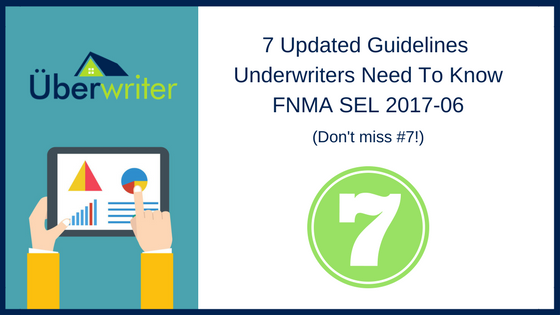Many people have heard the rumors and seen the blogs and articles about the DTI going up to 50% announced in the new DU 10.1 version now out in the market! Did you know there are other important updates in SEL 2017-06 that can help more credit worthy borrowers? Let’s review!
Changes announced in SEL 2017-06
Change 1 – Expanded DTI from 45% to 50%
No real explanation needed here, however not every loan will approve at the higher DTI. Therefore, it is worth a try if you have a turn down for DTI on DU 10.0. Trying the loan under DU 10.1 might be the trick.
Change 2 – Increased LTV’s for ARMs
The great thing about ARMs are generally lower rates, but a larger down payment is required. FNMA has now taken away that requirement and expanded the ARM LTV’s to match LTV’s with almost all fixed rates on all occupancy and number of units! Check out the NEW CHART HERE
Change 3 – Employment offers or contracts
This change will help correspondents more than direct sellers or banks due to their flexibility to hold onto a loan until the borrower started their new job after closing. This new guideline applies to a borrower who is getting a new job and has not started the new job at the time of closing. This rule change allows the loan to be sold prior to the start date of employment which was not possible before. There are some restrictions such as one unit, purchases only, primary residence, no variable pay, etc provided the employment start date is within 90 days of the note date.
Change 4 – Disputed Trade lines
FNMA has given better direction on the DU findings about disputed trade lines. As a result, the new DU disputed trade lines will be given clear instructions on what the lender must due to investigate and document the information.
Change 5 – Time Share Accounts
There used to be some debate on the question “is a time share a mortgage debt, or installment debt”. Therefore DU 10.1 states that regardless of what the credit report states, time share loans are considered as installment loans, not mortgage loans. This change will correct issues when running loans through DU and creating confusion to the AUS on how many financed properties that are owned by the borrower.
Change 6 – Student loan debt clarification
DU 10.1 allows for a new option on determining student loan payment debts. Previously if a student loan was shown as zero on the credit report the lender would need to qualify the loan with either 1% of the balance as the payment OR follow the chart for estimating the payment based on prevailing student loan interest rates. Now if you can document that the reason the loan payment is zero is due to income based repayment plan you can use the zero to qualify.
Change 7- Alimony Treatment
This change has not been talked about much, but I promise it will save loans! FNMA now allows lenders to deduct alimony from the income instead of always counting it as a debt. Check this out…
OLD METHOD EXAMPLE
Gross income
$5,000 per month total income to qualify
DEBTS
$1000 PITI Subject
$1000 Rev / Installment / Student Loan
$500 Alimony Payment
$2,500 Total Debt
50% DTI
NEW METHOD EXAMPLE
Gross income
$5,000 per month
($500) per month alimony now allowed to be deducted from the income
$4,500 total income to qualify
DEBTS
$1000 PITI Subject
$1000 Rev / Installment / Student Loan
$2,000 Total Debt
44.4 DTI
I know I have seen many great blogs an articles about the new 50% DTI which is great, but as you can see that is not the only improvement on SEL 2017-06 to pay attention to!


7 Responses
Great information on updates! As always! Thank you!
Thanks Michael for the illustration on the old way and new way of calculating the Alimony. I have been producing loans for many years and never realized it affected the debt ratio that significantly.
HELP HELP
IAM HAVING A MAJOR ISSUE WITH MY BORROWER REGARDING A STUDENT LOAN.
MY BUYERS STUDENT LOAN PAYMENT SHOWS UP ON THE CREDIT REPORT AS A VERY LOW PAYMENT BECAUSE IT IS INCOME BASED.
MY BUYER ALSO IS IN A PUBLIC SERVICE LOAN FORGIVENESS PROGRAM.
MY BUYER IS GOING FHA
Good News Tracey! FNMA is now allowing these low payment to qualify as of a few days ago! Check out FNMA B3-6-05 Monthly Debt Obligations!
Student Loans
If a monthly student loan payment is provided on the credit report, the lender may use that amount for qualifying purposes.
If the credit report does not reflect the correct monthly payment, the lender may use the monthly payment that is on the student
loan documentation (the most recent student loan statement) to qualify the borrower.
If the credit report does not provide a monthly payment for the student loan, or if the credit report shows $0 as the monthly
payment, the lender must determine the qualifying monthly payment using one of the options below.
• If the borrower is on an income-driven payment plan, the lender may obtain student loan documentation to verify the
actual monthly payment is $0. The lender may then qualify the borrower with a $0 payment.
• For deferred loans or loans in forbearance, the lender may calculate
– a payment equal to 1% of the outstanding student loan balance (even if this amount is lower than the actual fully
amortizing payment), or
– a fully amortizing payment using the documented loan repayment terms.
Thank you for posting
Please share on New Article. Texas 50(A)-6.
Hi Sanjeev
Thank you for the comment I will add this to the list of topics to talk about in the future!